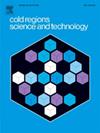Evaluation of pull-out behavior of headed stud connectors under freeze-thaw cycles: Experimental and numerical studies
IF 3.8
2区 工程技术
Q1 ENGINEERING, CIVIL
引用次数: 0
Abstract
In order to determine the pull-out capacity and failure mechanisms of headed stud connectors under freeze-thaw cycles (FTCs), freeze-thaw and pull-out tests were performed on thirty-six pull-out specimens with varying effective embedment depths (60 mm, 90 mm, and 110 mm) subjected to 0, 50, 75, and 100 FTCs. Failure modes, concrete strength, dynamic elastic modulus, mass loss rate, and load-displacement behavior of the specimens after different FTCs were presented and discussed. Experimental results indicated that the degradation of pull-out capacity (Pu) is significantly affected by freeze-thaw damage, particularly after 50 FTCs. Increasing the number of FTCs from 0 to 50 and 100 times, the Pu decreased by 14.9 % and 38.7 %, respectively. Results also indicated that the Pu was enlarged by the magnification of the embedment depth. Increasing the embedment depth from 60 to 90 and 110 mm, the Pu magnified by 65.0 % and 171.1 %, respectively. A finite element (FE) model was further established to gain insight into the effects of concrete strength, effective embedment depth, and stud head diameter on the Pu after FTCs. Numerical results indicated that smaller embedment depths and stud head diameters reduced freeze-thaw resistance, while freeze-thaw damage was minimally influenced by concrete strength. Increasing embedment depth and stud head diameter is recommended to improve the freeze-thaw resistance of pull-out capacity. Furthermore, an analytical model that considers the number of freeze-thaw cycles that is capable of predicting the pull-out capacity of headed studs after freeze-thaw damage was proposed.
冻融循环下头螺柱连接件拔拔性能的评估:实验和数值研究
为了确定冻融循环(FTCs)下头螺柱连接器的拔出能力和失效机制,对36个具有不同有效嵌入深度(60 mm、90 mm和110 mm)的拔出试件进行了冻融和拔出试验,分别受到0、50、75和100个FTCs的影响。介绍并讨论了不同FTCs后试件的破坏模式、混凝土强度、动弹性模量、质量损失率和荷载-位移特性。试验结果表明,冻融损伤对拔拔能力(Pu)的退化有显著影响,特别是50次冻融损伤后。当FTCs从0次增加到50次和100次时,Pu分别下降14.9%和38.7%。结果还表明,随着埋置深度的增大,Pu增大。当埋置深度从60 mm增加到90 mm和110 mm时,Pu分别放大了65.0%和171.1%。进一步建立有限元模型,深入研究混凝土强度、有效埋深和螺栓头直径对FTCs后Pu的影响。数值结果表明,较小的埋设深度和钉头直径会降低混凝土的冻融阻力,而冻融损伤受混凝土强度的影响最小。建议增加埋设深度和螺柱头直径,以提高拔拔能力的抗冻融能力。在此基础上,建立了一个考虑冻融循环次数的分析模型,该模型能够预测螺栓冻融损伤后的拔拔能力。
本文章由计算机程序翻译,如有差异,请以英文原文为准。
求助全文
约1分钟内获得全文
求助全文
来源期刊

Cold Regions Science and Technology
工程技术-地球科学综合
CiteScore
7.40
自引率
12.20%
发文量
209
审稿时长
4.9 months
期刊介绍:
Cold Regions Science and Technology is an international journal dealing with the science and technical problems of cold environments in both the polar regions and more temperate locations. It includes fundamental aspects of cryospheric sciences which have applications for cold regions problems as well as engineering topics which relate to the cryosphere.
Emphasis is given to applied science with broad coverage of the physical and mechanical aspects of ice (including glaciers and sea ice), snow and snow avalanches, ice-water systems, ice-bonded soils and permafrost.
Relevant aspects of Earth science, materials science, offshore and river ice engineering are also of primary interest. These include icing of ships and structures as well as trafficability in cold environments. Technological advances for cold regions in research, development, and engineering practice are relevant to the journal. Theoretical papers must include a detailed discussion of the potential application of the theory to address cold regions problems. The journal serves a wide range of specialists, providing a medium for interdisciplinary communication and a convenient source of reference.
 求助内容:
求助内容: 应助结果提醒方式:
应助结果提醒方式:


